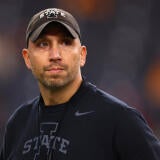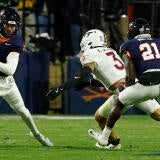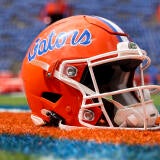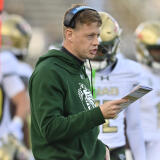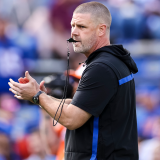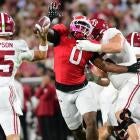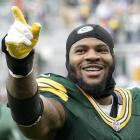Scout's Eye: How Florida's defense shut down Auburn; Georgia's offensive line faces test vs. South Carolina
Todd Grantham had the right plan for Gators defense, which may have turned a corner vs. the Tigers
Although No. 7 Florida is undefeated, it hadn't really looked like a top 10 team before last weekend's game against then-No. 7 Auburn. Tight wins over average Miami and Kentucky teams, a blowout of a bad version of Tennessee and two wins against FCS programs made the Gators a little bit tough to peg.
But during Saturday's 24-13 win vs. the Tigers, Florida looked top 10-worthy.
For the Gators, it wasn't as much about their offense – a unit that got a few big plays, had a great gameplan and was good enough against a nasty Auburn defense – but was more about Todd Grantham's defense.
For things to click in a Gus Malzahn-led Auburn offense, a few different elements need to be operating in concert. A mobile quarterback has to threaten the defense with his legs, a deep threat has to be present in the passing game for play-action shots and a downhill running game needs to be effectively complemented by horizontal jet-sweep action with speedy all-purpose athletes.
Against Auburn, Florida's defense – the less-heralded of the two on the field – managed to poke at the right pressure points to make the Tigers' whole operation collapse. Quarterback Bo Nix threw three interceptions and rushed for just 18 yards. JaTarvious Whitlow failed to top the 100-yard rushing mark on 18 carries. Auburn's most potent horizontal threat, Anthony Schwartz managed one carry for -4 yards and only Seth Williams' presence as the play-action shot target managed much of a substantive impact with his four catches for 79 yards and a score.
From the first drive of the game, it was clear that Florida wasn't going to let Auburn's orbit or jet sweep motion occupy its defensive front. Instead of allowing Schwartz to 'block' a defender by slowing the edge or influencing the linebackers, all of the East-West action was handled on the back end by the defensive backs. That mentality allowed Jonathan Greenard and Florida's other edge players to continue to play aggressive and fast at the snap like we saw on the second play of the game.
We saw one instance when that wasn't the case though and it was the one time Auburn actually decided to give the ball to Schwartz. It was a look that Auburn had showed before with a compacted formation that offset the fullback and running back into the boundary with Schwartz in the slot to the field. It was the identical look that Auburn had found success with against Mississippi State one week earlier to the tune of a touchdown.
Florida was coached up on the look, recognized it and Greenard kept the edge this time, forcing Schwartz back inside to the linebackers.
The gameplan defensively for Grantham leaned on his defensive backs to factor into the run game quickly, often out of a two-high safety look. It also leaned on those guys to account for Schwartz, an Olympic-level sprinter in space. For some reason, Malzahn and Auburn never really tested Florida's ability to deliver on that gameplan but given the way the Florida defensive backs played elsewhere, there's no reason to think they wouldn't have been game. They tackled well, limiting Auburn to a long run of 16 yards. They caused fits for Nix out of zone coverage, limiting blitz packages and muddying up the coverage looks while picking off those three passes. The defensive gameplan – and effort - collectively limited Auburn to less than 10 yards on nine of its 15 drives (excluding the game's final play).
Next weekend, when it heads to Death Valley, an even bigger challenge awaits Florida. No. 5 LSU is almost the polar opposite in terms of the challenge it presents and Florida's confidence in those defensive backs will be tested in coverage. At this point though, doubt Grantham, Mullen and an edgy Florida team at your own risk.
Big on big between the hedges
South Carolina heads to No. 3 Georgia on Saturday as a significant underdog, out-manned in most spots on both sides of the ball. But when Georgia has the ball, one of the best, most competitive matchups in college football will be taking place on a down-by-down basis. Georgia will trot out one of the biggest, nastiest, most physical offensive lines in the nation. More succinctly stated, it may just be the best. But South Carolina will trot out the best defensive lineman that group has faced in Javon Kinlaw.
Two weeks ago, against Kentucky, Kinlaw had exactly one tackle. A look at the box score would say he was a non-factor, but I would expect Kentucky's offensive line would frame things differently. On just about every snap that Kinlaw was in that game, we saw Kentucky helmets snapping back as Kinlaw was re-establishing the line of scrimmage in the Wildcats' backfield consistently and even without making a play on the ball carrier, he was disrupting the operation.
Georgia prides itself on mashing defenses up front. It wants to tell you what play is coming and still execute it due to a wave of humanity anchored by Solomon Kindley, Trey Hill, Cade Mays and Ben Cleveland on the interior. Kinlaw has emerged as one of the few defenders in the nation that has the physical traits to be immovable to that kind of a crew.
Kinlaw was an Army All-American coming out of high school with undeniable traits but with a work-ethic, academically and otherwise, that held him back. After a stint in junior college, a switch flipped for the 6-foot-6, 310-pounder and he's been a force ever since. As NFL Draft first-round projections start to pop up, this weekend's challenge is a resume opportunity for Kinlaw to solidify that NFL Draft stock and the same can be said for the guys trying to block him.
Flashes from last weekend
Texas cornerback D'Shawn Jamison: No. 11 Texas found itself in a bit of a dog fight vs. West Virginia on Saturday and if not for four interceptions thrown by Austin Kendall, it may not have survived without a loss. The good news for Texas is that those interceptions weren't boneheaded plays by a rattled quarterbacks, they were ridiculous plays by a talented secondary. In particular, Jamison made some remarkable plays showcasing the kind of ball skills that he used while doubling as a receiver in high school. For Texas to beat Oklahoma this weekend, Jamison and his fellow defensive backs will need to find some similar opportunities against Sooners quarterback Jalen Hurts.
Baylor defensive lineman James Lynch: Matt Rhule has put an emphasis on recruiting athletes first and then developing them at Baylor. That goes for the entire field, every position. On the defensive line, Lynch is a great example of that. At 6-5, 282 pounds coming out of high school, Lynch ran a sub-5.0 40, a 4.30 shuttle and had nearly a 30-inch vertical leap. He also looked great in camp settings but he failed to attract interest from the in-state heavyweights. The development under Rhule has come. Lynch had three sacks as a freshman, 5.5 as a junior and after Saturday's three-sack performance against Kansas State, he's at six on the season and is looking like one of the top pass rushers in the nation through five games.
Virginia Tech defensive back Caleb Farley and tight end Dalton Keene: One of the surprising aspects of Virginia Tech's bad start to the 2019 season is the fact that this is not a staff that has recruited poorly by Virginia Tech standards. Talented players should be flashing by now and Saturday vs. Miami some of those talented players started to flash, notably Farley. Farley, a former quarterback, arrived in Blacksburg, Virginia, as a four-star prospect with elite speed and good length. With the ability to play either side of the football, Farley settled into a role as a defensive back and vs. the Hurricanes, he picked off two passes and broke up another. Out of the same recruiting class, Keene – a contributor since his freshman season – also stepped up against Miami with three touchdowns and 73 yards receiving. Keene also played high school quarterback in Colorado along with a number of other positions before landing at tight end for Virginia Tech. Both are elite athletes, former four-stars, recruited by Justin Fuente. For Virginia Tech to turn the corner, these kind of performances need to become the norm.



